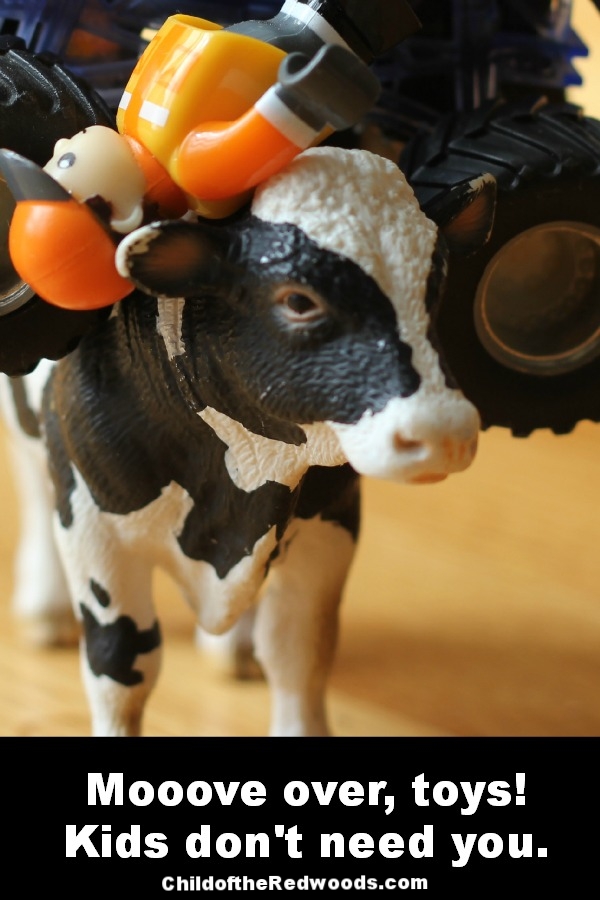Get Rid of (Most of) Your Kids Toys
Every three months or so I go crazy decluttering my house and removing nearly all of the children's toys. I'm not an organized person by nature, so while my minimalist goals may never be reached, I find the process necessary for my own sanity.
While I'm on the three month declutter mission, my closets fill with giant garbage bags and fill up with items for the Goodwill: clothes, instantly regretted IKEA purchases, and of course, some of the children's toys.
It's the toys, of course, that are the hardest for me to part with. Not only would my children heavily protest if they saw the way I snuck out half their closet into a garbage bag, the toys are memory burdens for me, too. They remind me of the family members who gave them to us and also of the time flown by. Weren't my children so much younger just six months ago?
Toys, Not Manipulatives
As a Montessori homeschooling parent, I've got a lot of materials at our disposal on several shelves in my dining room. A shelf of reading, writing, and art supplies, a shelf for math manipulatives, and a shelf for science and geography.
These are different from toys. They're purposeful and available at all times but also not to be carried around willy nilly as one likes. The children know the difference between the two. I'm not talking about purging these precious learning materials. (At least not yet.)
I'm talking about the junky stuff. Toy cars, talking Elmos, costumes, plastic baubles, check-out line plastic nonsense, old party favors, stuffed animals. They creep into our house with the holidays from relatives and impulse buys. They're scattered underneath the couch and behind dressers.
Some are favorites, like Nuff, the giant stuffed alligator that my husband bought our oldest for his birthday just before his brother was born. And some are just sentimental, like the wooden baby toys I can't seem to part with.
Will They Notice?
While I'm picking out items to Goodwill, I am suddenly swept up in a catharsis of cleanliness. If their bedroom looks and feels better with fewer toys out, would it feel even better with no toys at all?
I begin stuffing toys into ziplock baggies and tucking them into the downstairs closet until all that is left in their room is clothes and books.
I still fear that my children will hate me for this, but every time they surprise me. They don't even notice that the toys have disappeared. At least, not in the sense I am afraid of.
Will They Care?
If anything, they seem to relish the dramatic change. They slide around on the bare floor in socks and dive under the blankets and tell each other stories under the glow of a flashlight. They leap in circles around the house, as if their bodies are literally lighter than before the purge.
Out come the scissors and paper and glue. Ideas for new projects appear out of nowhere. Suddenly, we can all concentrate on our real work without the distractions. It's good for us. So, so good.
The Choice
Did you know that Maria Montessori's first classroom was full of toys? Her school was a social project, and it received a lot of publicity. Many wealthy people wanted to help the poor, neglected children she was working with, and from these donations, the children had lovely, high-end toys to play with.
She noticed something odd, though. The toys were gathering dust.
Maria was curious. She tried to spark an interest by rearranging them and sitting down to play with the toys herself, "showing them how to handle the tiny dishes, lighting the fire in the doll's kitchen, and placing it near a pretty doll." (The Secret of Childhood)
The children simply were not inspired. Their attention spans were much shorter with the toys than the other activities in the classroom, and they did not even notice when she removed them.
Her conclusion? Children use toys to pass their time, much like an adult uses a game of chess. (Or in modern times, perhaps a app game?) It's relaxing and fun. But when something important comes along, the game is forgotten. We have jobs to do. The real world wins.
Real Work Appeals
It's the same with children and toys. A few open-ended toys are fine. They can make a room cheerier. They can be used in imaginative dramatic play. Soft ones can be cuddled. The ones with wheels can race. Dolls can be tended to.
But you don't need many, and it's not because fantasy play is evil. It's because they are passing fancies when compared to the real work a child chooses in order to learn a developmental skill.
My current purge-fest is almost finished. We have a few baskets in the living room - a set of rainbow blocks, a few cars, a basket of playsilks and fun fabrics, a toy ukulele, and a plastic gears set. Oh, and the walkie talkies! Those are fun! In the bedroom, the only toy is a wizard puppet that I bought for my classroom before the children were born. I really love him, but he's almost like a decoration - rarely played with.
Downstairs in a closet where the children like to play alone is where I've thrown the remaining stuffed animals. Do we still have too many? I'm still on the hunt, looking for things that don't enhance our lives but make a mess in our heads.
Even though the motivation's high, it's probably time to pause. In another three months, I'll do it again.

